Comprehensive Report: Market Development and Sales Strategies
VerifiedAdded on 2020/04/21
|9
|1312
|128
Report
AI Summary
This report delves into the critical aspects of market development and sales, focusing on the sales process and the importance of active listening. It introduces the SIER hierarchy of active listening, outlining sensing, interpreting, evaluating, and responding. The report then examines key practices for effective listening in sales, emphasizing the need to listen more than speak. It further analyzes various types of sales resistance, using mobile phones as a case study to illustrate customer objections such as company unfamiliarity, high prices, and delays. Finally, the report provides recommended approaches to address these objections, including sharing facts and statistics, emphasizing product value, and highlighting time-sensitive offers. This report provides valuable insights into understanding and improving sales techniques.

Running head: MARKET DEVELOPMENT AND SALES
Market Development and Sales
Name of the Student:
Name of the University:
Author Note:
Market Development and Sales
Name of the Student:
Name of the University:
Author Note:
Paraphrase This Document
Need a fresh take? Get an instant paraphrase of this document with our AI Paraphraser
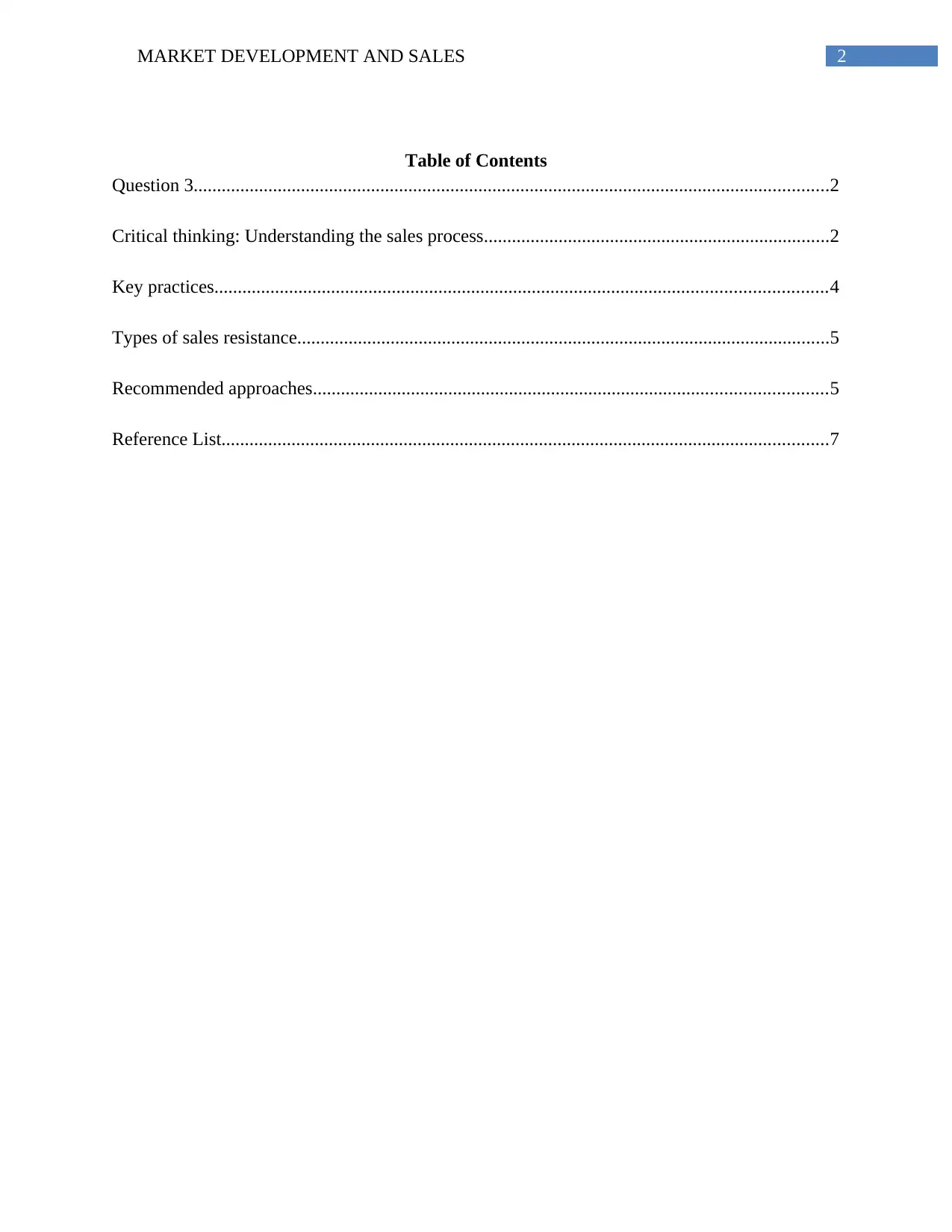
2MARKET DEVELOPMENT AND SALES
Table of Contents
Question 3........................................................................................................................................2
Critical thinking: Understanding the sales process..........................................................................2
Key practices...................................................................................................................................4
Types of sales resistance..................................................................................................................5
Recommended approaches..............................................................................................................5
Reference List..................................................................................................................................7
Table of Contents
Question 3........................................................................................................................................2
Critical thinking: Understanding the sales process..........................................................................2
Key practices...................................................................................................................................4
Types of sales resistance..................................................................................................................5
Recommended approaches..............................................................................................................5
Reference List..................................................................................................................................7
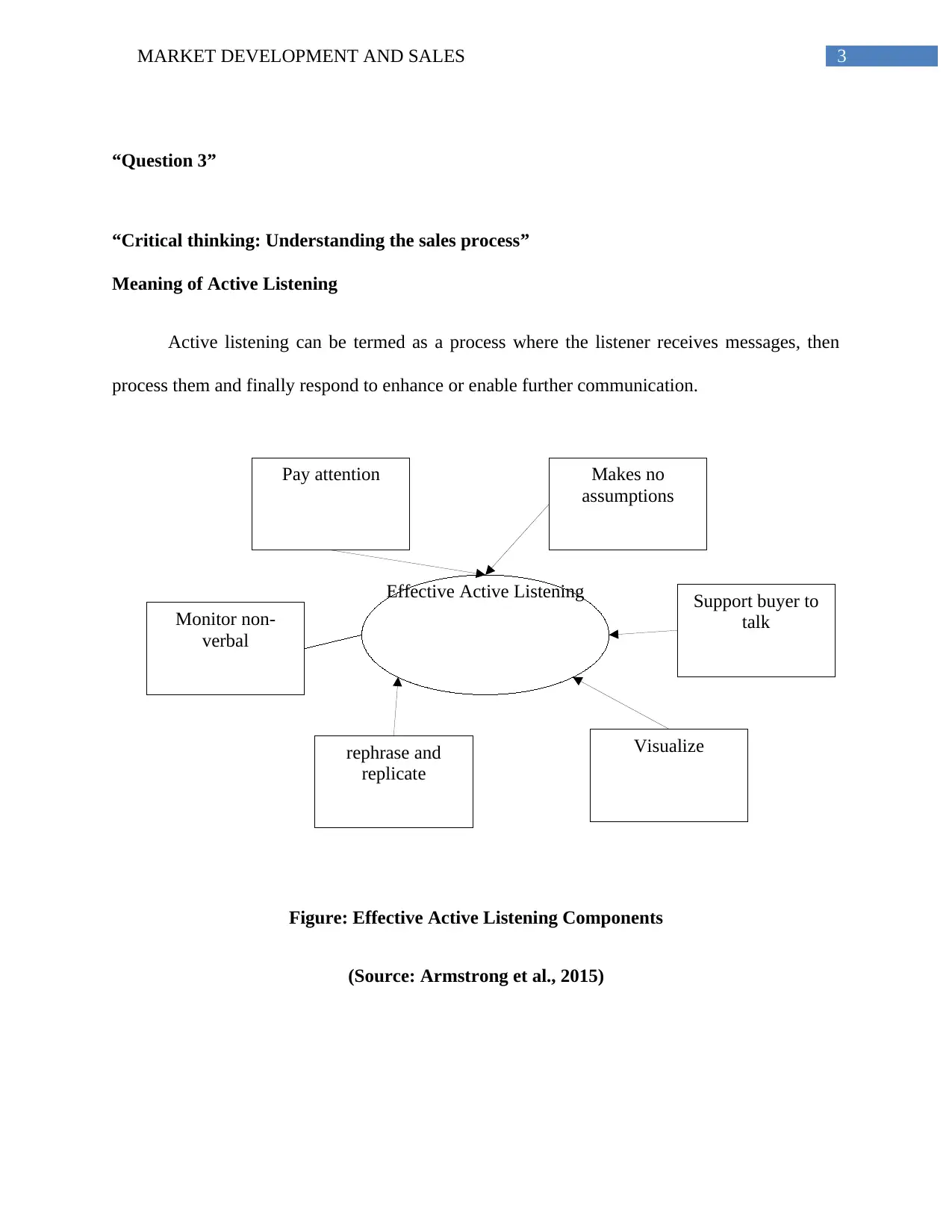
3MARKET DEVELOPMENT AND SALES
Effective Active Listening
Pay attention
Monitor non-
verbal
rephrase and
replicate
Makes no
assumptions
Support buyer to
talk
Visualize
“Question 3”
“Critical thinking: Understanding the sales process”
Meaning of Active Listening
Active listening can be termed as a process where the listener receives messages, then
process them and finally respond to enhance or enable further communication.
Figure: Effective Active Listening Components
(Source: Armstrong et al., 2015)
Effective Active Listening
Pay attention
Monitor non-
verbal
rephrase and
replicate
Makes no
assumptions
Support buyer to
talk
Visualize
“Question 3”
“Critical thinking: Understanding the sales process”
Meaning of Active Listening
Active listening can be termed as a process where the listener receives messages, then
process them and finally respond to enhance or enable further communication.
Figure: Effective Active Listening Components
(Source: Armstrong et al., 2015)
⊘ This is a preview!⊘
Do you want full access?
Subscribe today to unlock all pages.

Trusted by 1+ million students worldwide
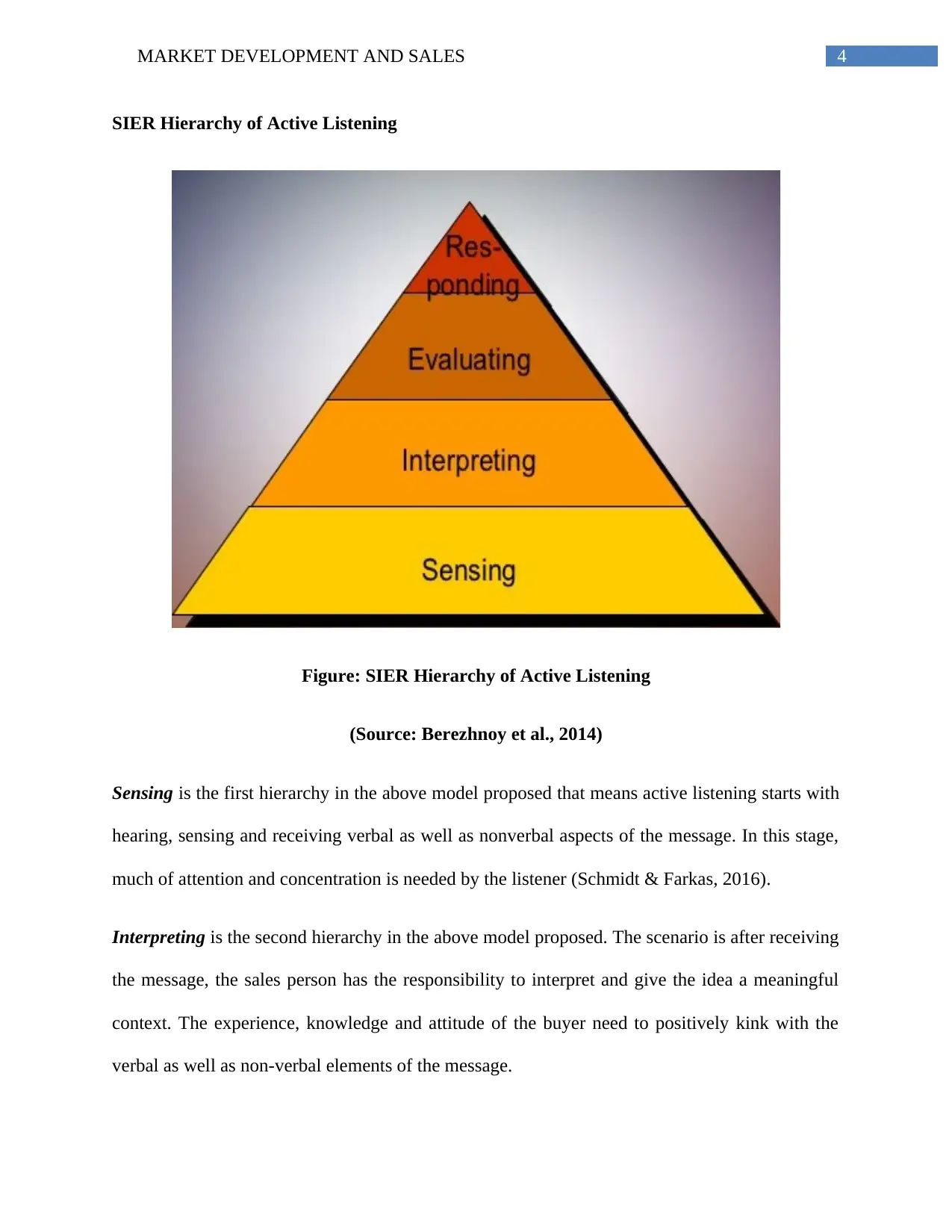
4MARKET DEVELOPMENT AND SALES
SIER Hierarchy of Active Listening
Figure: SIER Hierarchy of Active Listening
(Source: Berezhnoy et al., 2014)
Sensing is the first hierarchy in the above model proposed that means active listening starts with
hearing, sensing and receiving verbal as well as nonverbal aspects of the message. In this stage,
much of attention and concentration is needed by the listener (Schmidt & Farkas, 2016).
Interpreting is the second hierarchy in the above model proposed. The scenario is after receiving
the message, the sales person has the responsibility to interpret and give the idea a meaningful
context. The experience, knowledge and attitude of the buyer need to positively kink with the
verbal as well as non-verbal elements of the message.
SIER Hierarchy of Active Listening
Figure: SIER Hierarchy of Active Listening
(Source: Berezhnoy et al., 2014)
Sensing is the first hierarchy in the above model proposed that means active listening starts with
hearing, sensing and receiving verbal as well as nonverbal aspects of the message. In this stage,
much of attention and concentration is needed by the listener (Schmidt & Farkas, 2016).
Interpreting is the second hierarchy in the above model proposed. The scenario is after receiving
the message, the sales person has the responsibility to interpret and give the idea a meaningful
context. The experience, knowledge and attitude of the buyer need to positively kink with the
verbal as well as non-verbal elements of the message.
Paraphrase This Document
Need a fresh take? Get an instant paraphrase of this document with our AI Paraphraser
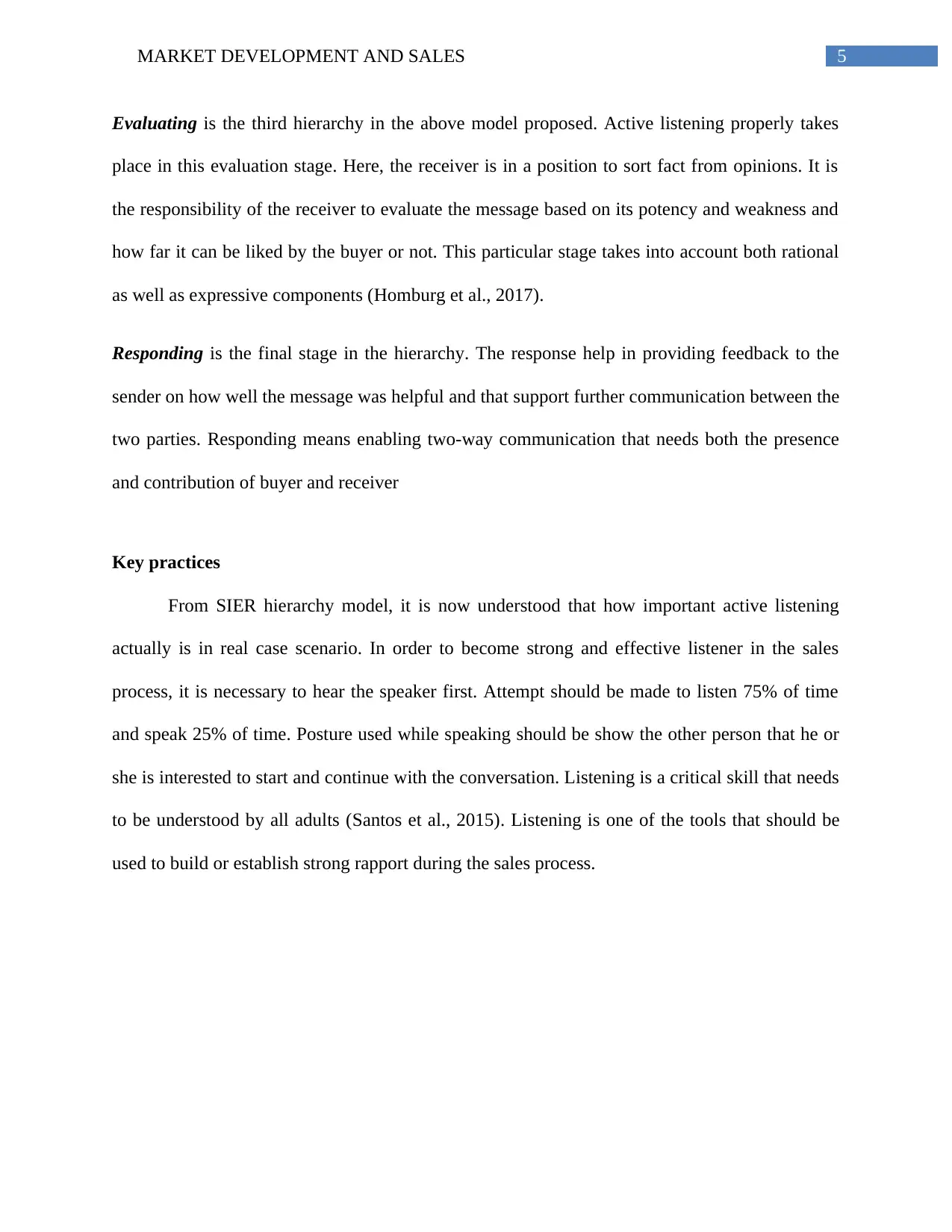
5MARKET DEVELOPMENT AND SALES
Evaluating is the third hierarchy in the above model proposed. Active listening properly takes
place in this evaluation stage. Here, the receiver is in a position to sort fact from opinions. It is
the responsibility of the receiver to evaluate the message based on its potency and weakness and
how far it can be liked by the buyer or not. This particular stage takes into account both rational
as well as expressive components (Homburg et al., 2017).
Responding is the final stage in the hierarchy. The response help in providing feedback to the
sender on how well the message was helpful and that support further communication between the
two parties. Responding means enabling two-way communication that needs both the presence
and contribution of buyer and receiver
Key practices
From SIER hierarchy model, it is now understood that how important active listening
actually is in real case scenario. In order to become strong and effective listener in the sales
process, it is necessary to hear the speaker first. Attempt should be made to listen 75% of time
and speak 25% of time. Posture used while speaking should be show the other person that he or
she is interested to start and continue with the conversation. Listening is a critical skill that needs
to be understood by all adults (Santos et al., 2015). Listening is one of the tools that should be
used to build or establish strong rapport during the sales process.
Evaluating is the third hierarchy in the above model proposed. Active listening properly takes
place in this evaluation stage. Here, the receiver is in a position to sort fact from opinions. It is
the responsibility of the receiver to evaluate the message based on its potency and weakness and
how far it can be liked by the buyer or not. This particular stage takes into account both rational
as well as expressive components (Homburg et al., 2017).
Responding is the final stage in the hierarchy. The response help in providing feedback to the
sender on how well the message was helpful and that support further communication between the
two parties. Responding means enabling two-way communication that needs both the presence
and contribution of buyer and receiver
Key practices
From SIER hierarchy model, it is now understood that how important active listening
actually is in real case scenario. In order to become strong and effective listener in the sales
process, it is necessary to hear the speaker first. Attempt should be made to listen 75% of time
and speak 25% of time. Posture used while speaking should be show the other person that he or
she is interested to start and continue with the conversation. Listening is a critical skill that needs
to be understood by all adults (Santos et al., 2015). Listening is one of the tools that should be
used to build or establish strong rapport during the sales process.
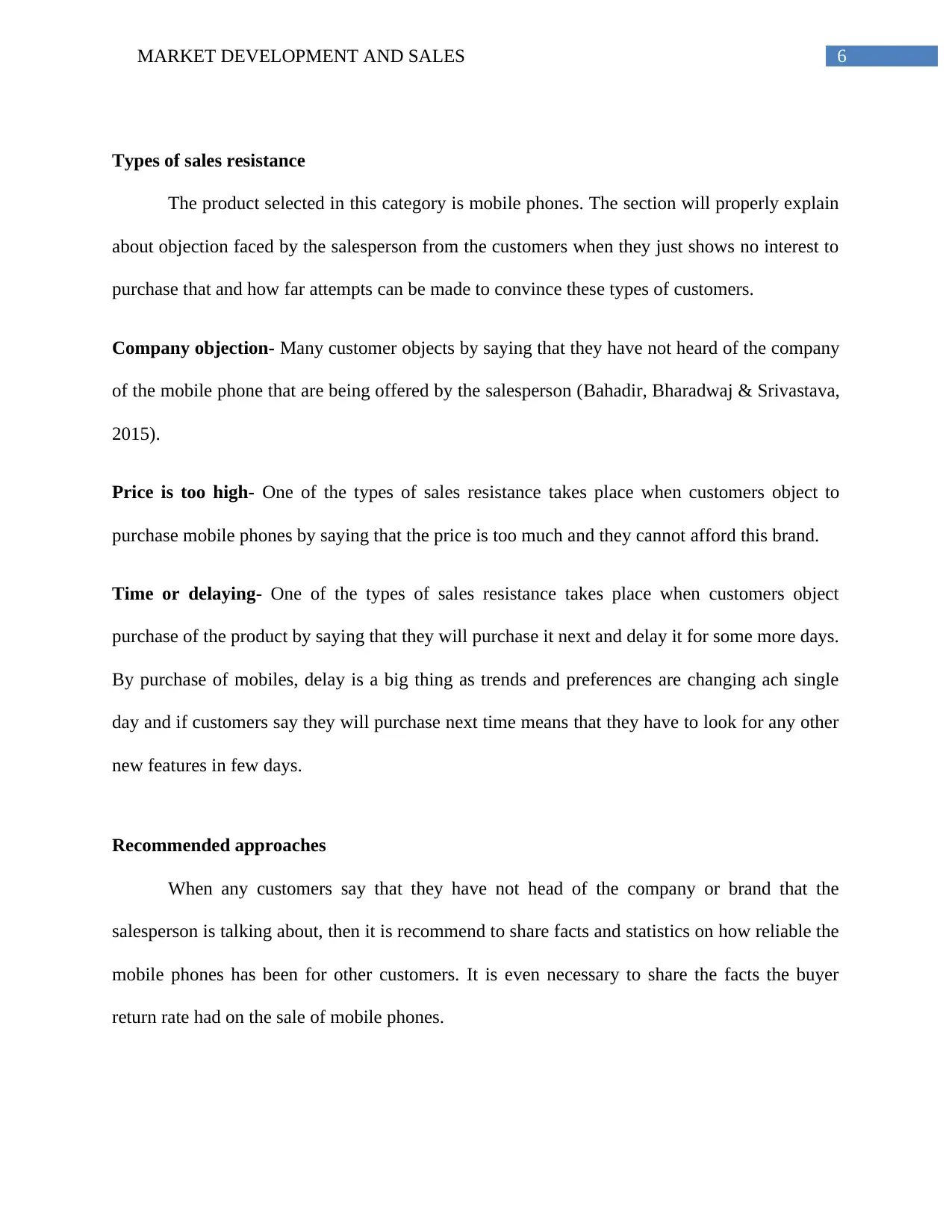
6MARKET DEVELOPMENT AND SALES
Types of sales resistance
The product selected in this category is mobile phones. The section will properly explain
about objection faced by the salesperson from the customers when they just shows no interest to
purchase that and how far attempts can be made to convince these types of customers.
Company objection- Many customer objects by saying that they have not heard of the company
of the mobile phone that are being offered by the salesperson (Bahadir, Bharadwaj & Srivastava,
2015).
Price is too high- One of the types of sales resistance takes place when customers object to
purchase mobile phones by saying that the price is too much and they cannot afford this brand.
Time or delaying- One of the types of sales resistance takes place when customers object
purchase of the product by saying that they will purchase it next and delay it for some more days.
By purchase of mobiles, delay is a big thing as trends and preferences are changing ach single
day and if customers say they will purchase next time means that they have to look for any other
new features in few days.
Recommended approaches
When any customers say that they have not head of the company or brand that the
salesperson is talking about, then it is recommend to share facts and statistics on how reliable the
mobile phones has been for other customers. It is even necessary to share the facts the buyer
return rate had on the sale of mobile phones.
Types of sales resistance
The product selected in this category is mobile phones. The section will properly explain
about objection faced by the salesperson from the customers when they just shows no interest to
purchase that and how far attempts can be made to convince these types of customers.
Company objection- Many customer objects by saying that they have not heard of the company
of the mobile phone that are being offered by the salesperson (Bahadir, Bharadwaj & Srivastava,
2015).
Price is too high- One of the types of sales resistance takes place when customers object to
purchase mobile phones by saying that the price is too much and they cannot afford this brand.
Time or delaying- One of the types of sales resistance takes place when customers object
purchase of the product by saying that they will purchase it next and delay it for some more days.
By purchase of mobiles, delay is a big thing as trends and preferences are changing ach single
day and if customers say they will purchase next time means that they have to look for any other
new features in few days.
Recommended approaches
When any customers say that they have not head of the company or brand that the
salesperson is talking about, then it is recommend to share facts and statistics on how reliable the
mobile phones has been for other customers. It is even necessary to share the facts the buyer
return rate had on the sale of mobile phones.
⊘ This is a preview!⊘
Do you want full access?
Subscribe today to unlock all pages.

Trusted by 1+ million students worldwide
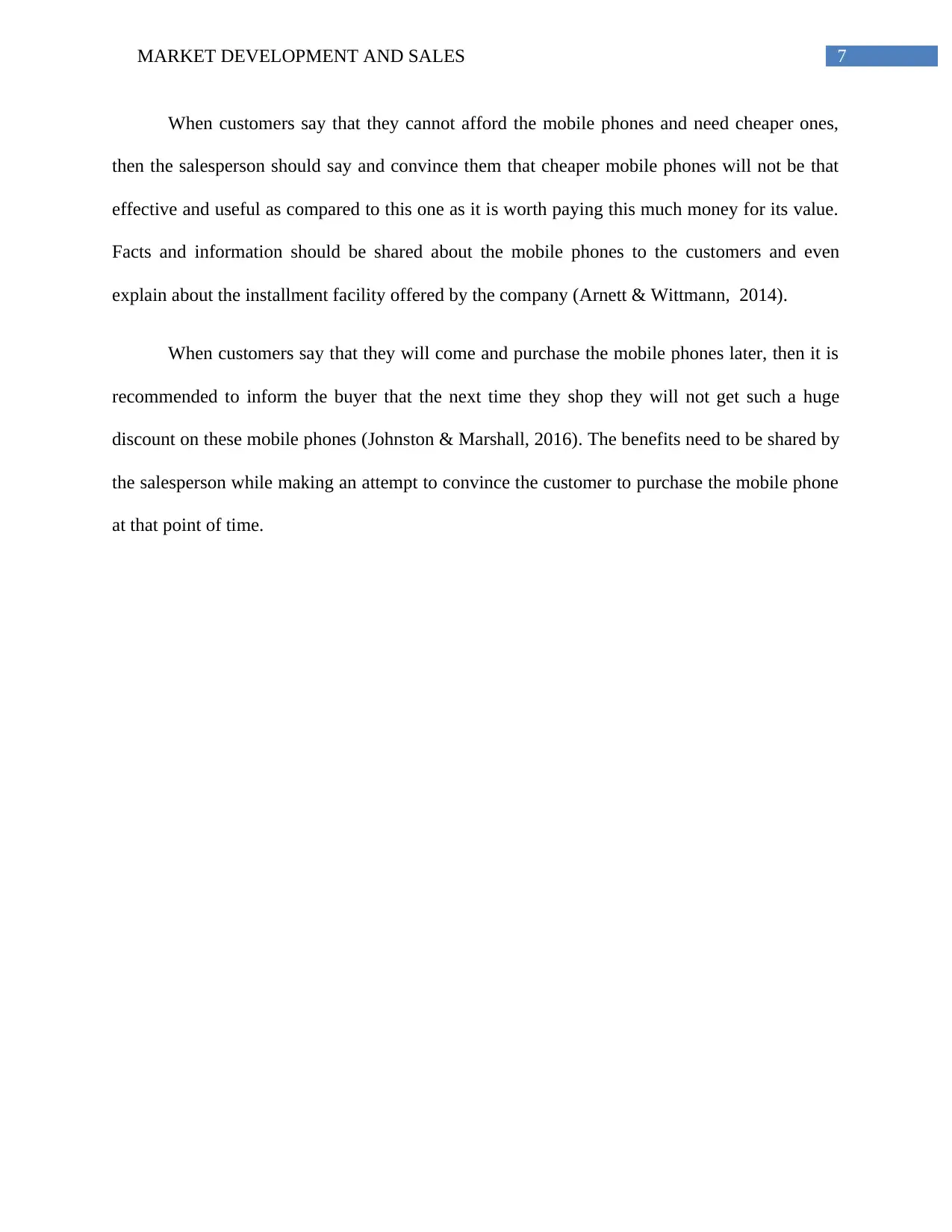
7MARKET DEVELOPMENT AND SALES
When customers say that they cannot afford the mobile phones and need cheaper ones,
then the salesperson should say and convince them that cheaper mobile phones will not be that
effective and useful as compared to this one as it is worth paying this much money for its value.
Facts and information should be shared about the mobile phones to the customers and even
explain about the installment facility offered by the company (Arnett & Wittmann, 2014).
When customers say that they will come and purchase the mobile phones later, then it is
recommended to inform the buyer that the next time they shop they will not get such a huge
discount on these mobile phones (Johnston & Marshall, 2016). The benefits need to be shared by
the salesperson while making an attempt to convince the customer to purchase the mobile phone
at that point of time.
When customers say that they cannot afford the mobile phones and need cheaper ones,
then the salesperson should say and convince them that cheaper mobile phones will not be that
effective and useful as compared to this one as it is worth paying this much money for its value.
Facts and information should be shared about the mobile phones to the customers and even
explain about the installment facility offered by the company (Arnett & Wittmann, 2014).
When customers say that they will come and purchase the mobile phones later, then it is
recommended to inform the buyer that the next time they shop they will not get such a huge
discount on these mobile phones (Johnston & Marshall, 2016). The benefits need to be shared by
the salesperson while making an attempt to convince the customer to purchase the mobile phone
at that point of time.
Paraphrase This Document
Need a fresh take? Get an instant paraphrase of this document with our AI Paraphraser
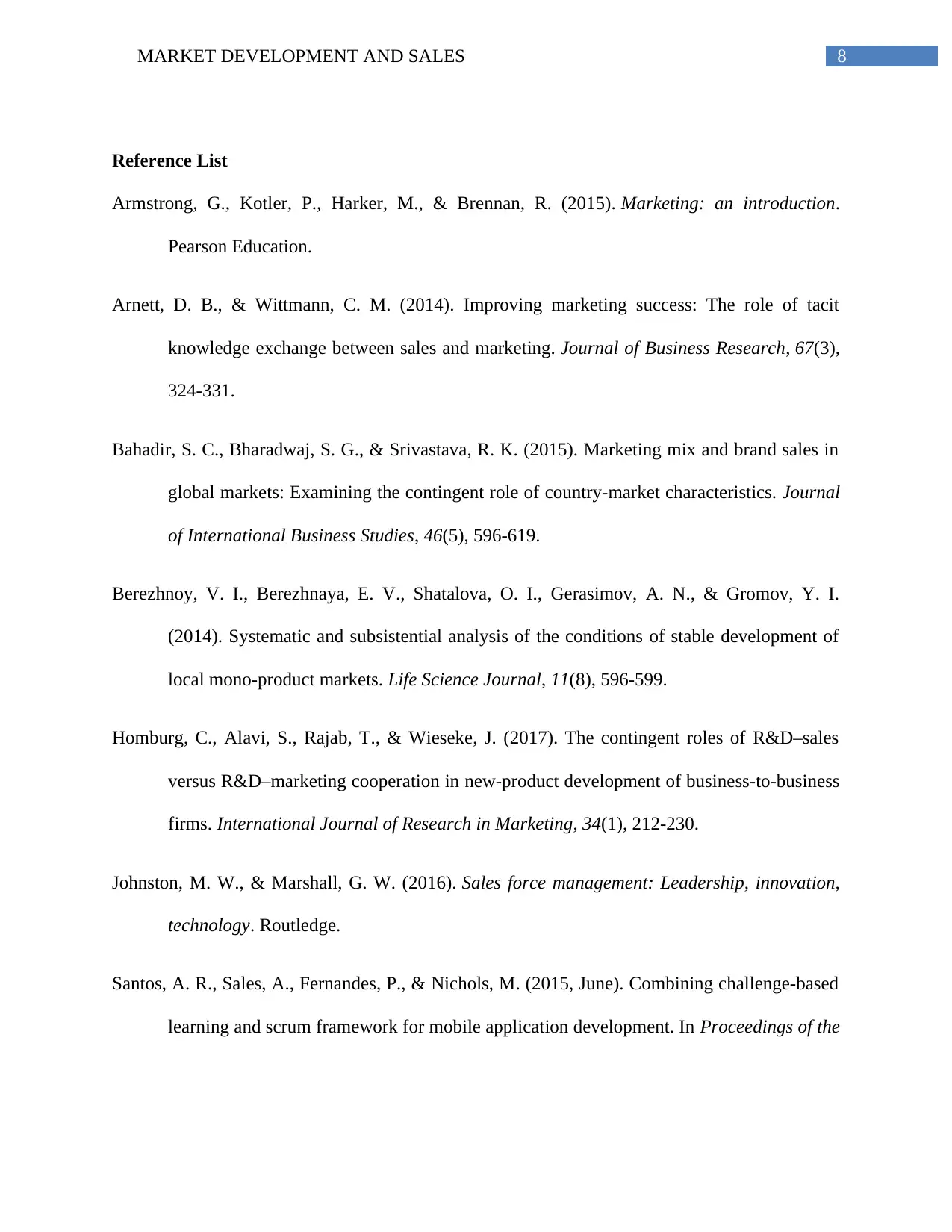
8MARKET DEVELOPMENT AND SALES
Reference List
Armstrong, G., Kotler, P., Harker, M., & Brennan, R. (2015). Marketing: an introduction.
Pearson Education.
Arnett, D. B., & Wittmann, C. M. (2014). Improving marketing success: The role of tacit
knowledge exchange between sales and marketing. Journal of Business Research, 67(3),
324-331.
Bahadir, S. C., Bharadwaj, S. G., & Srivastava, R. K. (2015). Marketing mix and brand sales in
global markets: Examining the contingent role of country-market characteristics. Journal
of International Business Studies, 46(5), 596-619.
Berezhnoy, V. I., Berezhnaya, E. V., Shatalova, O. I., Gerasimov, A. N., & Gromov, Y. I.
(2014). Systematic and subsistential analysis of the conditions of stable development of
local mono-product markets. Life Science Journal, 11(8), 596-599.
Homburg, C., Alavi, S., Rajab, T., & Wieseke, J. (2017). The contingent roles of R&D–sales
versus R&D–marketing cooperation in new-product development of business-to-business
firms. International Journal of Research in Marketing, 34(1), 212-230.
Johnston, M. W., & Marshall, G. W. (2016). Sales force management: Leadership, innovation,
technology. Routledge.
Santos, A. R., Sales, A., Fernandes, P., & Nichols, M. (2015, June). Combining challenge-based
learning and scrum framework for mobile application development. In Proceedings of the
Reference List
Armstrong, G., Kotler, P., Harker, M., & Brennan, R. (2015). Marketing: an introduction.
Pearson Education.
Arnett, D. B., & Wittmann, C. M. (2014). Improving marketing success: The role of tacit
knowledge exchange between sales and marketing. Journal of Business Research, 67(3),
324-331.
Bahadir, S. C., Bharadwaj, S. G., & Srivastava, R. K. (2015). Marketing mix and brand sales in
global markets: Examining the contingent role of country-market characteristics. Journal
of International Business Studies, 46(5), 596-619.
Berezhnoy, V. I., Berezhnaya, E. V., Shatalova, O. I., Gerasimov, A. N., & Gromov, Y. I.
(2014). Systematic and subsistential analysis of the conditions of stable development of
local mono-product markets. Life Science Journal, 11(8), 596-599.
Homburg, C., Alavi, S., Rajab, T., & Wieseke, J. (2017). The contingent roles of R&D–sales
versus R&D–marketing cooperation in new-product development of business-to-business
firms. International Journal of Research in Marketing, 34(1), 212-230.
Johnston, M. W., & Marshall, G. W. (2016). Sales force management: Leadership, innovation,
technology. Routledge.
Santos, A. R., Sales, A., Fernandes, P., & Nichols, M. (2015, June). Combining challenge-based
learning and scrum framework for mobile application development. In Proceedings of the
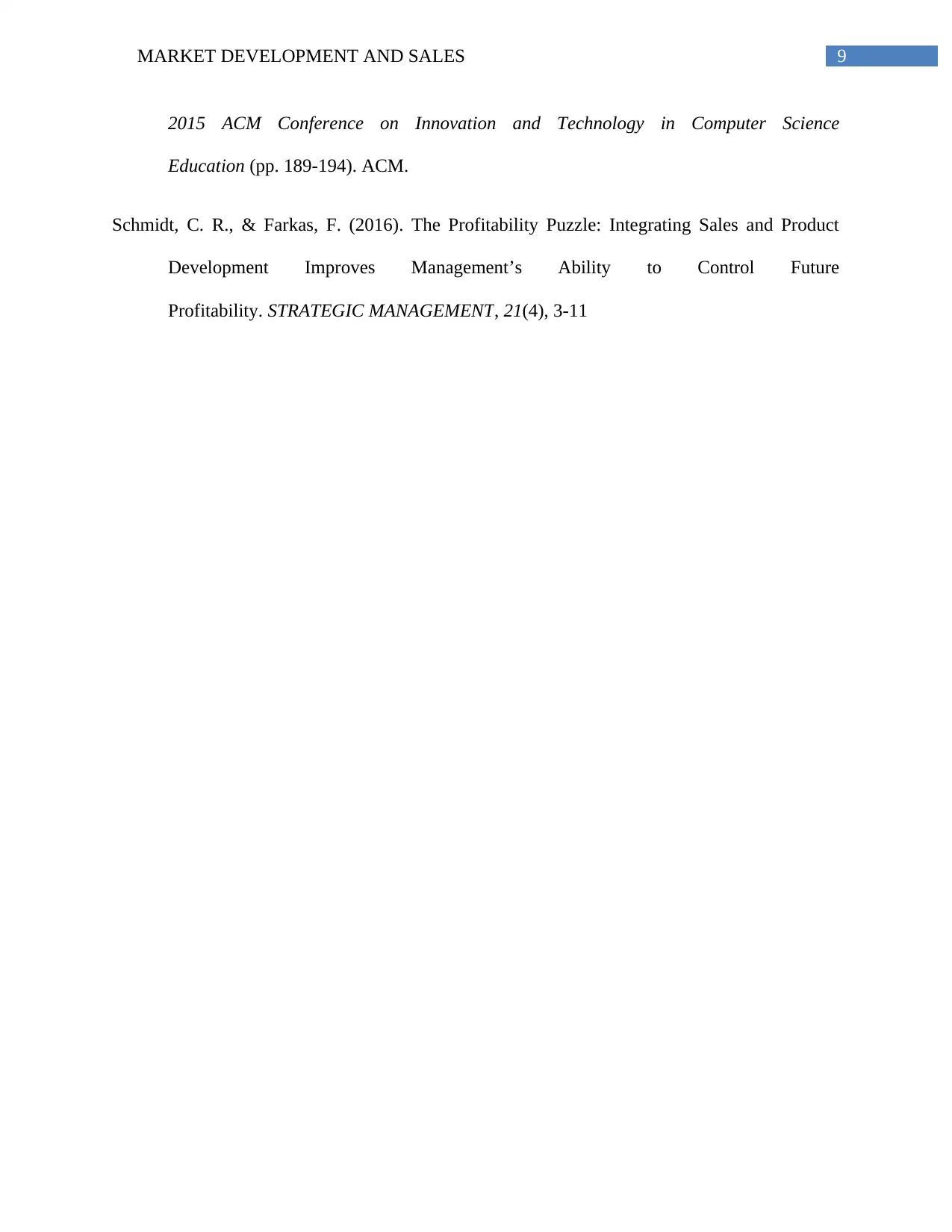
9MARKET DEVELOPMENT AND SALES
2015 ACM Conference on Innovation and Technology in Computer Science
Education (pp. 189-194). ACM.
Schmidt, C. R., & Farkas, F. (2016). The Profitability Puzzle: Integrating Sales and Product
Development Improves Management’s Ability to Control Future
Profitability. STRATEGIC MANAGEMENT, 21(4), 3-11
2015 ACM Conference on Innovation and Technology in Computer Science
Education (pp. 189-194). ACM.
Schmidt, C. R., & Farkas, F. (2016). The Profitability Puzzle: Integrating Sales and Product
Development Improves Management’s Ability to Control Future
Profitability. STRATEGIC MANAGEMENT, 21(4), 3-11
⊘ This is a preview!⊘
Do you want full access?
Subscribe today to unlock all pages.

Trusted by 1+ million students worldwide
1 out of 9
Related Documents
Your All-in-One AI-Powered Toolkit for Academic Success.
+13062052269
info@desklib.com
Available 24*7 on WhatsApp / Email
![[object Object]](/_next/static/media/star-bottom.7253800d.svg)
Unlock your academic potential
Copyright © 2020–2025 A2Z Services. All Rights Reserved. Developed and managed by ZUCOL.




